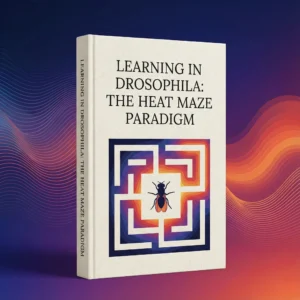

The 8-arm radial maze is a widely used experimental apparatus in behavioral neuroscience and psychology, designed to study spatial learning and memory in rodents, primarily rats and mice. This maze consists of a central platform from which eight arms radiate outwards like the spokes of a wheel. Each arm can be baited with a food reward, and the primary goal for the animal is to locate and remember the arms containing the rewards.
It was first introduced by Olton and Samuelson in 1976 as a tool to explore the cognitive processes involved in memory and learning.[1] Since its inception, the 8-arm radial maze has become a standard tool for investigating various aspects of spatial navigation, working memory, and reference memory.

Figure: The 8 Radial Arm Maze
The typical 8-arm radial maze comprises a central platform connected to eight equidistantly spaced arms. Each arm can be equipped with a food well at the far end, which can be baited with a reward. The design allows for easy observation and recording of the animal’s movements, making it an excellent apparatus for detailed behavioral analysis.[2]
A mouse starts on a central platform and explores the arms to find food rewards, such as pellets or sweetened milk. After each arm visit, the mouse returns to the center and typically waits for a few seconds while access to the arms is temporarily blocked. It’s important to note that the mouse cannot see the food, and any potential influence of smell is carefully controlled.
What exactly is measured? A variety of behavioral parameters can be assessed, including (but not limited to):
Each parameter provides insight into various cognitive processes that contribute to the mice’s ability to navigate the maze. For instance, by monitoring two distinct types of errors made by the mice, researchers can examine two forms of memory: working memory and reference memory.
Working Memory is often confused with short-term memory. While short-term memory involves holding information for brief periods, working memory refers to the capacity to manipulate or use the held information. It is crucial for tasks that require temporary storage and management of information, such as solving problems or following a sequence of steps.[2]
Reference Memory pertains to the long-term retention of information that remains constant over time. It involves the recall of stable information necessary for specific situations, such as remembering which arms of the maze contain rewards across multiple trials.[2]
By studying these memory types through the errors and choices mice make in the maze, scientists gain a deeper understanding of the cognitive mechanisms underlying spatial learning and memory.
In this experimental setup (Figure 1), food is placed at the end of every arm in the maze. The mouse starts from the central platform and must explore each arm to collect all the rewards. If the mouse enters an arm it has already visited during the same trial, it is considered a working-memory error. These errors occur when the mouse fails to remember which arms it has previously explored, demonstrating a lapse in its ability to temporarily store and manipulate information regarding its recent choices. [3]
The trial concludes when the mouse has successfully collected the food from all eight arms. The total number of working-memory errors made during a trial can vary widely, as there is no upper limit on the number of errors a mouse can make. This allows researchers to measure the mouse’s working memory capacity in a comprehensive manner.
Tracking these errors provides valuable data on the mouse’s cognitive function, specifically its working memory. The more errors a mouse makes, the more it indicates difficulties in retaining and using information about its recent actions. Conversely, fewer errors suggest a stronger working memory. This setup enables scientists to analyze the effectiveness of different interventions, such as drugs or genetic modifications, on the mouse’s cognitive abilities.
Figure 1: A sample task designed to test working memory. (1) All arms are baited, and the mouse waits for doors to open. (2) 1st choice: always gets the cheese. (3) 2nd choice: Mouse correctly chooses a new arm. (4) 3rd choice: Mouse re-enters an already chosen arm, committing a working-memory error, and laments his damaged hippocampus.
In another experimental setup (Figure 2), food rewards are consistently placed in the same four arms of the maze for every trial. The mouse starts from the central platform and must navigate the arms to locate and retrieve the food. If the mouse enters an arm that does not contain food, it is recorded as a reference-memory error. These errors reflect the mouse’s inability to remember and apply the consistent spatial information about which arms are baited.[3]
The trial concludes when the mouse has collected all the food from the baited arms. To ensure accuracy in measuring reference memory and to prevent working-memory errors, access to any previously traveled arms is blocked after each choice. This design guarantees that the mouse cannot re-enter an arm it has already visited within the same trial.
As a result, the first choice has eight options available, the second choice has seven remaining options, and so on, progressively reducing the number of available arms. The maximum number of reference-memory errors a mouse can make in a single trial is four, which corresponds to the mouse choosing all four unbaited arms before finding all the baited ones.
This setup provides a clear and focused measure of reference memory, as it requires the mouse to recall and utilize the stable information about the baited arms across trials. The fewer reference-memory errors a mouse makes, the better it demonstrates its ability to remember which arms consistently contain food. Researchers use this data to evaluate the effects of various factors, such as environmental changes, pharmacological treatments, or genetic manipulations, on the mouse’s long-term spatial memory and learning capabilities.
Figure 2: A sample task designed to test reference memory. (Top) The mouse waits for the doors to open before the 50th trial. He has already done 49 trials in which the same 4 arms were baited every time. (Middle) 1st choice: The mouse correctly goes to one of the baited arms. (Bottom) 2nd choice: Access to previously chosen arms is denied. The mouse chooses an arm that has never been baited, committing a reference-memory error. Not depicted, brief period before each choice in which all doors are closed.
By adjusting the task parameters, researchers can vary the memory load, which is crucial because memory impairments are often subtle and may only become apparent under specific conditions. Utilizing both types of tasks mentioned above (or variations thereof) is essential because deficits in working memory and reference memory can be dissociated, meaning one can occur independently of the other.
Furthermore, by altering the affective states of the animals or employing rodent models of diseases, the 8-arm radial maze becomes a powerful tool for studying the interactions between reference and working memory systems and other brain networks. Certain disease states are known to preferentially affect one type of memory over another. For example, some strokes are more likely to impair reference memory while leaving working memory relatively intact. Consequently, rodent models of these conditions are often used with maze tasks that target the more relevant type of memory impairment.
This ability to dissociate and manipulate different memory systems provides valuable insights into the underlying mechanisms of memory and its related disorders. Researchers can investigate how specific brain regions and networks contribute to various types of memory and how these systems are altered in disease states. By understanding these interactions, scientists can develop more targeted therapeutic interventions for memory-related conditions.
The 8-arm radial maze is a vital tool in behavioral neuroscience, offering profound insights into the cognitive processes underlying spatial learning and memory in rodents. By utilizing this maze, researchers can systematically study the intricacies of working memory and reference memory, differentiating between these two types of memory and understanding their unique contributions to overall cognitive function.
Through various experimental manipulations, such as adjusting task parameters, controlling sensory cues, and employing rodent models of human diseases, the 8-arm radial maze allows for the exploration of how different brain regions and networks interact. This has significant implications for our understanding of neural mechanisms, cognitive impairments, and potential therapeutic interventions.
The maze’s ability to measure subtle memory impairments under controlled conditions makes it an indispensable tool for studying memory-related disorders and the effects of pharmacological agents. As research continues to evolve, the 8-arm radial maze will undoubtedly remain a cornerstone in the field, driving advancements in our comprehension of memory systems and contributing to the development of targeted treatments for cognitive deficits.
Niewoehner B, Single FN, Hvalby Ø, Jensen V, Meyer zum Alten Borgloh S, Seeburg PH, Rawlins JN, Sprengel R, Bannerman DM. (2007). Impaired spatial working memory but spared spatial reference memory following functional loss of NMDA receptors in the dentate gyrus. Eur J Neurosci, 25(3):837-46.

Vanja works as the Social Media and Academic Program Manager at Conduct Science. With a Bachelor's degree in Molecular Biology and Physiology and a Master's degree in Human Molecular Biology, Vanja is dedicated to sharing scientific knowledge on social media platforms. Additionally, Vanja provides direct support to the editorial board at Conduct Science Academic Publishing House.
